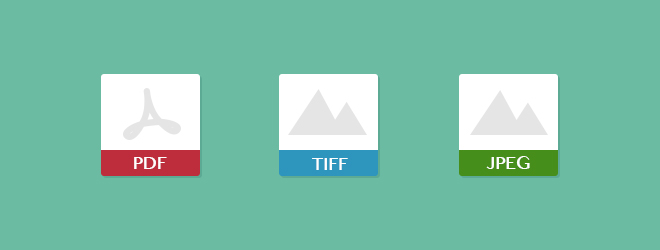Ideal Document File Formats for Digital Document Management

More and more companies and institutions are implementing digital document management systems for daily work processes to improve efficiency and save money. To ensure an optimal problem-free system, it’s often a good idea to implement standards-based technologies. It’s important to use certain document file formats for saving and collaboration. So, when digitizing documents, what are the ideal document types / standards to use?
Three document file formats are arguably the most popular in digital document management. They are JPEG, PDF, and TIFF.
TIFF vs. JPEG vs. PDF
Let’s explore them and their characteristics. This includes covering how to choose the proper type depending on a variety of requirements you may face.
TIFF or TIF Format
TIFF or TIF, short for Tagged Image File Format, was created in the 1980s. It still remains a popular format for storing raster image data. TIFF supports lossless compression formats (e.g. fax, LZW, ZIP). Lossless compression may be critical in some environments where a concern exists for image quality. Image quality degradation does not occur with non-lossless compression. This is unlike the JPEG algorithm. With JPEG, additional compression is added with each save. Thus, image quality is also reduced with each save. More about JPEG later…
TIFF also supports sophisticated color management features. This includes the support of CMYK color model, different color spaces, and the use of transparencies and layers. You can also use TIFF to create images in high resolution, with lossless quality, which are suitable for high-resolution printing. It’s a good option for storing archival masters of digitized images for better exchange and transfer.
In summary, TIFF format comes with
- Lossless compression
- Sophisticated color management features
- Support for high resolution
JPEG
JPEG stands for Joint Photographic Experts Group. The group developed standards in connection with the file format in the early 1990s.
Today, the format is well-suited for applications requiring fast online access. This is because JPEG has an increased level of compression to greatly reduce file sizes. However, as mentioned, this comes at a cost of lost image quality. If you will have users doing multiple edits to a document using JPEG this format may not be preferred, at least not as the only one you use.
You might consider a combination of using TIFF to capture and save originals so edits can be done as needed. Then you can output final versions to JPEG for optimal transfer and access speeds.
JPEG is widely used to represent continuous tone images (e.g. photographs and greyscale images). The format doesn’t store many details like color space, transparencies, layers etc. So, it’s not as suitable for printing.
In summary, JPEG format comes with
- Increased level of compression to reduce file sizes
- Optimal access speed at a cost of lost image quality
- No color management features
Next is the PDF format, which is short for Portable Document Format. It’s a format introduced in the early 1990s by Adobe. To this day, PDF is a universally accepted file format for distributing, viewing and printing electronic documents. It is based on the PostScript computer language.
A PDF document provides great visual clarity. It contains elements including text, vector images, raster images and more.
PDF also supports searching within a file by metadata and text. For scanned documents saved as a PDF, a search can then be done by running optical character recognition (OCR) software. OCR is capable of reading text from a scanned print document to convert that text to editable, readable or searchable formats.
PDF also supports security features including password protection, electronic signatures, and rights management.
In summary, PDF format comes with
- Great visual clarity
- Searching within a file by metadata and text
- Security features
Choosing a Format
So how does one go about making the proper selection for a file format in any given document management system? It mainly depends on how the document(s) will be used in the future.
For example, if you are primarily concerned with presenting scanned documents with smooth color for web usage, JPEG would be a good option. But, if you need a digital document with a high resolution because you may need to later print it or have images requiring good details, TIFF is probably more ideal. Then again, if the document contains confidential information, a PDF has the security features you’ll require.
Besides TIFF, JEPG and PDF, there are other common document types such as PNG, BMP, and more. Each document type has its own merits and advantages as well as disadvantages. It’s likely that in most cases you will need to use multiple formats to cover multiple scenarios. So, you might find yourself adopting one format over another depending on the situation. Thus, it’s most important that your document management solution is capable of options. In other words, make sure it can let you pick from any popular format so you’re not locked in when you need options.
Scan and Save Documents Using Dynamic Web TWAIN
Dynamic Web TWAIN is an innovative browser-based document scanning SDK. It offers a clean and simple API for you to interact with scanners and hides the nitty-gritty of adapting to the ever-changing browsers and the variety of scanners.
Dynamic Web TWAIN has been playing as a small yet necessary piece in many enterprise-grade web applications and government programs for 15+ years. So, rest assured that Dynamsoft will continuously improve the SDK for the years to come.
How to scan documents and save using Dynamic Web TWAIN >
If you have any comments, please feel free to share with us.



 Blog
Blog